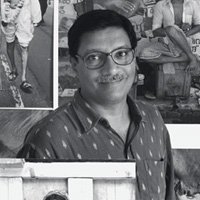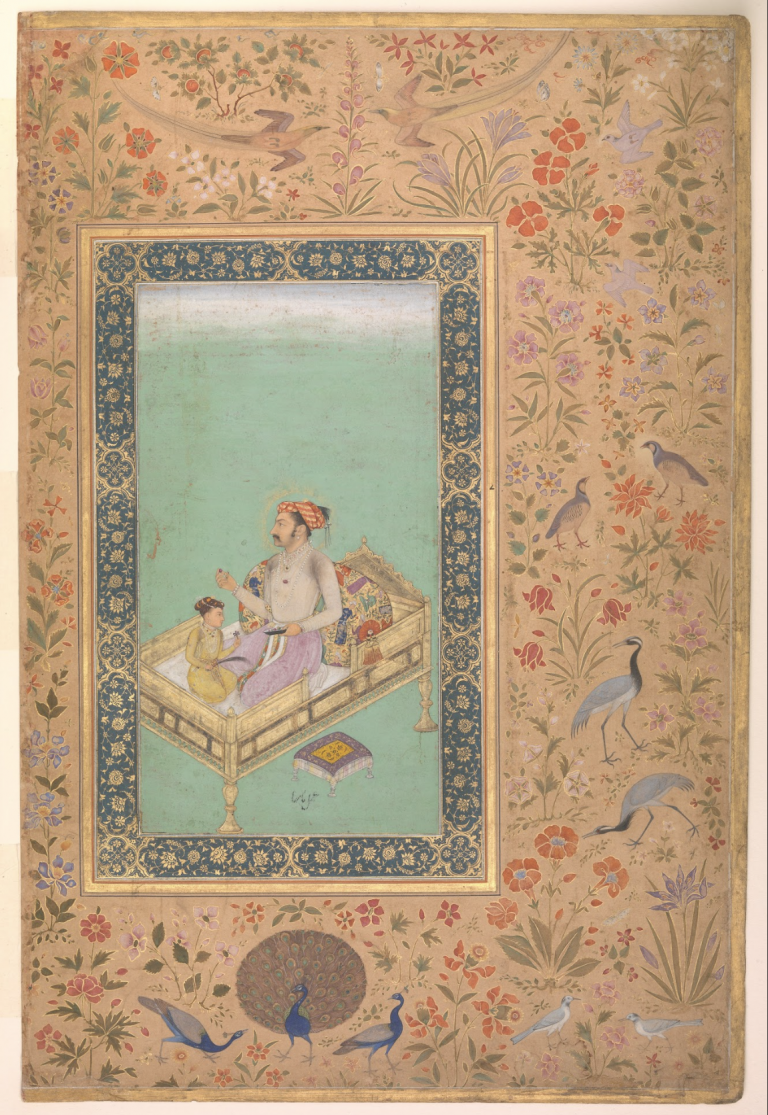
My parents, architect Habib Rahman and classical dancer Indrani Rahman, moved to Delhi with my sister Sukanya from Calcutta in 1953 on the urging of Jawaharlal Nehru (he brought my father to the Central Public Works Department from the West Bengal PWD). In their practice and persona they were perfect examples of the cultural adventure which took place in the first decade of the newly independent India. Much has been written about the statist vision of the ‘Nehruvian Modern’ and it is now fashionable to examine that period with a critical eye. But we should not forget that for artists of my parents generation, this was a moment of real idealism, a rare conjunction of historical forces where people like them actually contributed on a significant scale to shape the cultural imagination of a ‘Modern’ India.

Their first home in Delhi was in the Constitution House army barracks on Curzon Road, which housed all the artistic nomads whom Nehru was actively bringing to Delhi – Prithviraj Kapoor, Ram Dhamija, Simki – the small rooms laid out in rows had all kinds of creative crazies along with young bureaucrats coming to Delhi to staff the government offices. When they moved, their flat in Sujan Singh Park quickly became an adda for the arts community. In those days, the creative community was very small, and Delhi attracted people from all over India – almost everyone knew everyone else. My father, having been trained under Bauhaus teachers in the US, was the center of architects, furniture designers, textile designers who were embarked on the great adventure of making an ‘Indian’ modern. My mother, as a classical dancer, was in the forefront of bringing the classical forms on to the urban stage, which was also a part of the making of our modern identity. The house was filled with classical musicians, dance gurus, film makers, writers, painters and architects. There was a real camaderie and a sense of sharing in this creative journey which cut across all fields.



This was the culture into which I was born in 1955. MF Husain was staying in our house when my father called Inder Gujral to bring his younger brother Satish to meet ‘this interesting painter from Bombay’. I found this photograph of Inder, my mother and me, Satish, Husain and Charles Fabri after my father died in 1995. My father was a serious photographer and used a rolleiflex camera to photograph all his own buildings. Charles Fabri had moved to Delhi from Lahore and was a scholar and critic of Hungarian origin who became a Buddhist. Charles was the most influential critic in Delhi in those days, writing in The Statesman in Delhi, as well as regularly in British art and dance journals. He wrote on painting, theatre, dance and architecture. Evenings in our house would see regular parties with my father stripping down to his waist to perform his version of Martha Graham’s dances while Charles would sit and do his version of Navarasa’s in the Manipuri style – a style not known for its abhinaya! Ravi Shankar, Husain, Satish Gujral, Biren De, Laxman Pai, Joseph Stein, Ruth and Cyrus Jhabvala, Elizabeth Brunner, Amarnath Sehgal would be part of the audience.

Husain made a portrait of my mother in 1956. I had always heard about the painting which had become legendary, but it had been destroyed and lost. I found the negative of the portrait of her with the painting in my father’s archives and made prints in my New York darkroom. I gave Husain a copy. There had been no other record of the painting. He remade the painting in New York in 1998 and carried it over to her flat. When she died at the shockingly young age of 68 a few months later, he wrote emotionally about the episode in his hand written Hindi autobiography MF Husain Ki Kahani – Apni Zabani published by Vani Prakashan. She had been his first muse, long before Madhuri Dixit!!


When I began to be serious about photography at MIT in the mid 1970s, Husain was showing at the Worcester Museum in Massachusetts. I had gone to the show organised by the collectors Chester and Davida Herwitz. When he heard from me I was doing photography, he pulled out a photographic print he had made in Switzerland. Part of a Mithuna series, he painted on a model, photographed her, made prints, cut and collaged them to make the finished work. He was experimenting with the still camera as he had earlier with the 16mm movie camera. Few people today are aware of his experimental films done in the 1960s, long before video-art became the norm. His film Through the Eye’s of a Painter made for the Films Division won the Silver Bear at the Berlin Film Festival in 1968.
The Politics on Husain
Husain and Habib Tanvir were both criticised for their initial support of Indira Gandhi at the beginning of the emergency in 1975. Husain more so because he had painted her as Durga (even though it was Atal Bihari Vajpayee who had first hailed her as that after the Bangladesh War in 1971).

But I was privy to the run up to the emergency and the conversations both had with my mother. Many have now forgotten that the RSS was very much a part of the movement against Mrs. Gandhi along with Jayaprakash Narayan. And many are unaware of the fear that the RSS invokes in anyone with a Muslim name. Both Husain and Habib Tanvir had supported Indira in the fear that the RSS would emerge more powerful if they had been successful then. Sanjay’s excesses happened later in the episode. Given the fate that has since befallen Husain, obviously that fear was not misplaced.

I had already been deeply involved with SAHMAT when the attacks on Husain began in 1996. We had rushed to the Academy of Fine Art and Literature founded by Arpana Caur’s mother Ajeet Caur, where BL Sharma ‘Prem’ of the BJP and artist Raghu Vyas arrived with a mob threatening to attack the gallery (1998). Jatin Das got attacked and chased because he was taken to be Muslim because of his beard. SAHMAT’s long and defence of Husain was based on the clear understanding that these accusations and attacks were purely communal and politically motivated and managed, having nothing to do with so-called ‘public sentiment’ which was the justification for these attacks. In our understanding, the issue went beyond the individual. As a society, we were allowing groups who were cynically using religious sentiment as a political weapon, and allowing them to set the terms of cultural and artistic practice. Having faced this ourselves, we understood too clearly the implications of these assaults on our society.

This concerted campaign against Husain was led by a hugely organised political machinery which had decades of experience in smearing by rumour. It was also clear to us that the new and instant communication media – Television, the internet and websites, were being used to great effect to spread communally distorted interpretations of his work. All this work had been made years before the campaign started, and was seen in the relatively limited circles of the art world.

The involvement of groups with violence as an agenda and a weapon has been shown by the fact that two key figures leading the campaign against the artist BL Sharma ‘Prem’ the ex-MP of the BJP, and the medical Dr RP Singh (who filed one of the newer cases against Husain in court), were both shown on the ‘Hindutva terror tapes’ on the television channel Headlines Today in July, discussing the possible assassination of the Vice President of India. Their association with the Sanatan Sanstha is also being investigated. The Home Minister has stated that this group is one involved in bomb blasts which have led to many deaths. This is the same group which runs the Hindu Janajagruti website which has led the online campaign against the artist.
It is ironic that the two works made by Husain cited by his Hindutva critics were not titled by him. And in both cases, the identifying titles were used to justify the accusations of supposed offence. The untitled lithograph from a Hanuman series was given the title Sita Rescued by the critic Suneet Chopra, and the painting titled Bharat Mata was given that title by the Apparao Gallery. Blasphemous interpretations and titles have been made of his work which had been in the public realm for years, in the pamphlets of Sanskar Bharati and the Hindutva websites. It is all the more ironic because Husain made scores of paintings on the Ramayan in the 1960s inspired by Ram Manohar Lohia for his Ramayan Mela’s near Hyderabad. These were filmed by Shanti Chowdhury being carried into villages on bullock carts in a film for the Films Division. He also made invitations and programs for the Delhi Ram Lila Committee for Dussehra in Delhi and also illustrated the Paumacharyam, the Jain Ramayan, for a Jain Trust. Unusually, these images by him were seen by people of religious faith outside the context of an art gallery.
Whatever may be the future artistic assessment of Husain’s legacy, in one way he is a unique figure in the contemporary scene. He has been steadfast in making work which is accessible to many people. No other artist has made the number of prints, lithographs, and silkscreens as he has. This was always with the aim that more people could have his images at a low cost. He is also passionate about Urdu poetry and has used works by great modern poets as an inspiration. He has written poetry himself and his Hindi autobiography is now regarded as a milestone in modern writing in Hindi. What have we lost as a result of this campaign against him? Chester Herwitz told me in New York after the attack on the Herwitz Gallery in Ahmedabad, that he would never place his huge collection of contemporary Indian art in India, which had been his intention. It ended up being divided between the Peabody Essex Museum in Salem Massachusetts and private collectors. Husain himself shut down the galleries he had set up privately…. Husain Sankalana in Bangalore, Ahmedabad and the Cinema Ghar in Hyderabad. But till as late as 2008, when I met him in Dubai to see his ‘Maria’ paintings and drawings from the 1950s, he was still wanting to house them somehow in India, his Janmabhoomi, in a small museum.

As a culture and polity I do not think we have understood the true meaning and implication of the exile into which Husain has been forced. We have not realised to what extent the communal campaign which peaked with the destruction of the Babri Masjid in December 1992, and the subsequent rise to power of the Hindutva forces, have transformed our cultural space forever. Who of these artists would have thought in the 1950s as they embarked on their quest for an Indian modernity rooted in our civilizational ethos that their quest would end like this…? As recounted by Geeta Kapur, shortly before his death, Ramu Gandhi had said in anguish “How can they possibly attack Husain..? He is like a child….he plays with his brush and colours and clay like our folk artists and toy makers….and sometimes, like them….he ends up making an icon”













